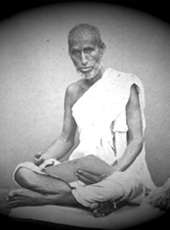Rajendrasuri
| Acharya Rajendrasuri | |
|---|---|
| आचार्य राजेंद्रसूरी | |
 | |
| Official name | Acharya Rajendrasuri |
| Religion | Jainism |
| Personal | |
| Born |
Ratna Raj 3 December 1827 Bharatpur, Rajasthan, India |
| Died |
21 December 1906 (aged 80) Mohankheda, Dhar, Madhya Pradesh |
| Parents | Rishabhadas Parakh, Keshardevi |
| Senior posting | |
| Successor | Achary Dhanchandrasuri |
| Religious career | |
| Works | Abhidhānarājaindrakōśa |
| Initiation |
Rajendrasuri Vaishakh Shukla 5 Vikram Samvat 1904 ( 1848 CE) Udaipur by Hemavijay |
| Part of a series on |
| Jainism |
|---|
 |
|
Jain prayers |
|
Ethics |
|
Major figures |
|
Major sects |
|
Festivals |
|
Pilgrimages |
|
|
Acharya Rajendrasuri (Hindi: आचार्य राजेंद्रसूरी) was a Svetambara Jain monk and reformer of monk traditions of 19th century. He wrote many books on Jainism including Abhidhānarājaindrakōśa (Sanskrit: अभिधानराजैंद्रकोश), a dictionary of Prakrit defining 60000 terms used in Jain works.
Early life
Acharya Rajendrasuri was born to businessman Rishabhadas Parakh and Keshardevi. His birth name was Ratna Raj. He was born on 3 December 1827 at Bharatpur, Rajasthan.[1][2][3]
Ascetic life
He was initiated as a Jain yati (wondering Jain monk) by Hemavijay at Udaipur on Vaishakh Shukla 5 Vikram Samvat 1904 (in 1848 CE) and given a new name, Ratnavijay. He was the first yati initiated in the 19th century.[2] Later his name was changed to Rajendrasuri upon his elevation to acharya rank.[3]
He studied under Pramodsuri and Jain yati monk Sagarchand. Dharanendrasuri, impressed by his scholarship, appointed him as his daftari. Ratnavijay was disapproved with the luxurious life of Dharanendrasuri and left him in 1864 AD. Later he became the leader of Tapa Gaccha.[3][4]
He led a movement in 1880 to reform yati tradition (order of wandering monks) at Jaora, resulting in near extinction of it. He opposed the luxurious life of the Jain yatis, contradictory to Jain principles of non-possession and non-violence. He issued a nine-point manifesto known as Nav-kalama. He explained nine principles to reform Jain yati tradition. His manifesto was accepted after some initial opposition. Many leading yati and monks gave up their luxurious life and started following Jain principles. He established Agama or Samakit Gaccha, later known as Tristutik Gaccha.[2][3][4]
He restored and reconstructed some Jain temples and consecrated 1023 icons of Tirthankaras.[2] He visited Rajasthan and Malwa where he delivered religious discourses in Malwi, Marwari languages. He also opposed worship of other gods and goddesses over the worship of Tirthankars.[3]
Rajendrasuri died on 21 December 1906[2] (Vikram Samvat 1963 Pous Shukla Saptami) at Mohankheda, Dhar, Madhya Pradesh. Later, Mohankheda became a centre for learning and a tirtha around 1940.[1][4]
Works
Rajendrasuri wrote, collected and edited some Jain works. He compiled the Prakrit dictionary, Abhidan-Rajendra Kosh, in seven volumes with 9200 pages describing 60000 terms.[2][3]
His works include:
- Abhidhānarājaindrakōśa
- Prakrit Vyakruti (Commentary on Grammar)
- Kalpasutra Prabodhini (Commentary on the Kalpasutra)
- Khartar Taskar Prabandh (Unpublished)
- Bhagawati Sutra Sateek
- Gachchhar Payanna
- Terapanth Prashnottar Vichara
- Mahanishitha Sutra (fifth)
- Brahata sangrihani
- Upasaka Dashanga Sutra
- Prakrit Shabda Rupawali
- Deepmalika Katha (Story of Diwali)
- Holika Katha (Story of Holi)
- Gandhara vad
- Karma Vichar (Unpublished)
- Tatva Vichar (Unpublished)
- Kalpasutra Balavabodh
- Jinupadesh Manjiri
- Kalyanmandir Stotra (Commentary)
- Jyotirya Kalpalata
- Swarodhya-gyan and Yantravali
- Vichar-sar Prakranam
- Sanskrit Vyakarnam (Sanskrit grammar)
- Laghu Sanghgrahani
- Amarkosh (Original)
- Navpad Puja Prasnothar
- Upadhan Vidhi
- Sratakatriyam (Bhatruhari)
- Chandrika Vyakaranam
- Kavyaprakash Mulamam
- Varnamala
- Upasaka Dashang Sutra
- Ek Sou Aath bol
- Upadesh Ratna saara
- Treloyaka Deepika Yantravali
- Karna Granth (four)
- Saptati Shatasthan Yantravali
- Dwashisth Margana Yantravali
- Shada Dravya Vichara
- Sidhnta Prakash
- Asthanhika Vyakhyana
- Sindura Prakara-satika
- Bhayhara Stotra
The original copy of these books are stored in libraries of Ahor, Rajasthan; Jaora; Mohankheda, Madhya Pradesh; Tharad and Ahmedabad in Gujarat.
Recognition
Shrines dedicated to him were erected at several places in India including Mohankheda, Bhinmal, Jalore, Bangalore, Bijapur, Ahemdabad, Tharad, Bharatpur, Indore, Ratlam, and Santhu etc. His death centenary was celebrated in 2006 at Mohankheda.
Successors
Following are the successors in his tradition:[1]
- Dhanachandrasuri (1839–1920)
- Bhupendrasuri (1887–1936)
- Yatindrasuri (1883–1960)
- Vidhyachandrasuri (1906–1982)
- Jayantsensuri (1984- )
- Hemendrasuri (1984–2010)
- Ravindrasuri
- Jayanandsuri
- Lekhendrshekharsuri
References
- 1 2 3 "Main Monks of Tradition" (PDF). www.jainuniversity.org (in Gujarati). p. 2. Retrieved 25 March 2013.
- 1 2 3 4 5 6 Shah, Natubhai (2004). Jainism: The World of Conquerors. 1. Motilal Banarsidass Publisher. p. 65. ISBN 9788120819382.
- 1 2 3 4 5 6 "Acharya Rajendrasuri: Biography". www.herenow4u.net. Retrieved 25 March 2013.
- 1 2 3 "Acharya Rajendrasuri". www.herenow4u.net. 23 April 2012. Retrieved 25 March 2013.